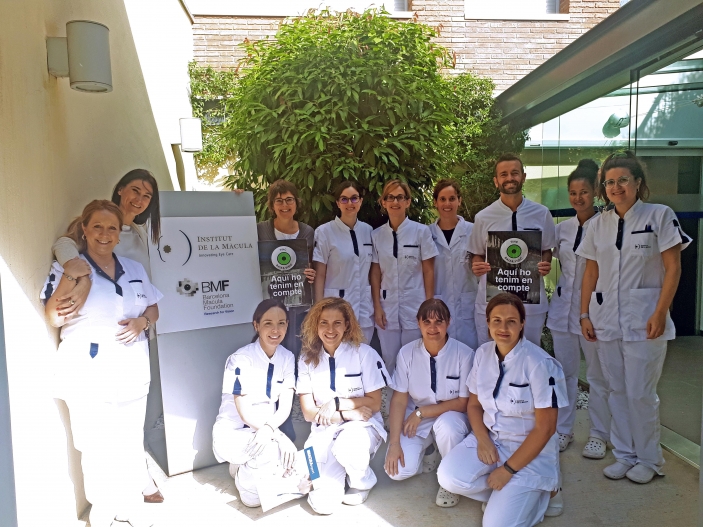“I Have Low Vision”, the badge of hope

Low vision is the condition suffered by people whose eyesight is impaired to the extent that their daily tasks are hard to carry out. On the occasion of World Sight Day, the Barcelona Macula Foundation and the Institut de la Màcula have joined the campaign to raise society’s awareness of those with low vision and the situations they face every day
To mark World Sight Day on Thursday 10 October, the Barcelona Macula Foundation and the Institut de la Màcula have maintained their commitment to research as the key to providing solutions as soon as possible. This year again, the two institutions have joined the campaign conducted in collaboration with associations and specialists throughout Spain to teach the general public about low vision and to facilitate understanding of a condition faced daily by sufferers.
“I Have Low Vision” reads the badge that has been launched for the campaign. It aims to raise the awareness of society, which largely considers eyesight as something that people either have or do not have, without realising that people, for example, can read a book but cannot see the number of a bus approaching the stop.
Student Helena Vidal and wine expert Laura Ruiz, two patients with Stargardt’s disease and who suffer from low vision, regard this as a badge of hope. “Hope and as an opportunity to achieve greater autonomy”, Helena says. Neither was aware of the badge but they are now in no doubt about how useful it will be.

“When I’m out, I can’t see faces. I can only see the people’s shape. Sometimes, I don’t greet people. Not because I don’t want to but because I can’t see them. And of course, some people don’t take too kindly to it”, Laura notes with concern. However, she feels that the badge that she will use from now on when she leaves home will help in this type of situation.
The two women, who are participating in a clinical trial at the Institut de la Màcula, believe that the “I Have Low Vision” badge will help to change prejudice and bias in society. “People don’t understand what low vision is,” explains Laura, who says she has been accused of being vain in some situations.
“I can’t distinguish coins so when I pay I leave the coins on the counter and ask the shop assistant to take them. One day, I was told ‘You’re so vain. It wouldn’t hurt you to wear glasses’. Since hen, I’ve usually paid by card,” says Laura, who speaks of being treated with unkindness “when I’ve asked what the next stop is on the train journey because I can’t read it”.
Helena has also found herself in similar situations. In her case, Stargardt’s disease makes it difficult for her to read the numbers on the screens that inform people of their turn, for example, in public buildings or in the market. “There are times when I can’t see my number and I stay seated in the waiting room,” she says. “Once, an official came out to find me and called out the number. When I stood up, she was rude to me because she was annoyed that I hadn’t got up.”

Helena doesn’t know anyone who uses the badge, but like Laura, sees it as “an opportunity.” “I struggle to read the number of the bus that’s approaching the stop because LEDs are difficult for me. I can hardly see the number until it’s close,” says Helena, who says she has missed buses because she didn’t react on time. “People are mostly kind and respond nicely; but as low vision is a condition that the other person isn’t aware of, as with other disabilities, sometimes you find people react badly,” she adds.
At the Barcelona Macula Foundation and the Institut de la Màcula, we have been working for years on treating and researching into diseases of the macula and the retina. We have played our part in the attempt to find a cure for vision loss and we are getting closer to achieving our goal.
However, even though we have been investigating to find the cure, a variety of diseases produce low vision in those who suffer from them. Pathologies such as age-related macular degeneration (AMD), retinitis pigmentosa, cataracts, diabetic retinopathy (RD) and glaucoma can be the origin of the reduction of the visual field that cannot be restored through surgery, pharmacological treatments or conventional glasses.
In this situation, patients suffer difficulties or inability to perform some day-to-day tasks, such as shopping, doing administrative tasks, waiting for the bus or standing in the queue at the market.
The Institut de la Màcula has placed the “I Have Low Vision” badge at the disposal of all those patients who are interested. The following video, made by our Begisare colleagues, explains what the badge signifies and 10 steps are taken to interact with who has low vision: